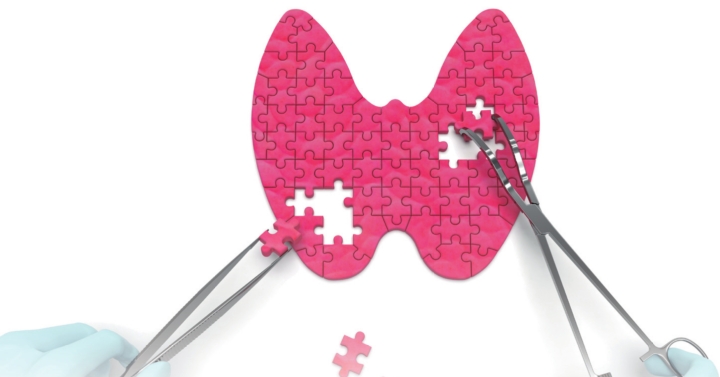
Stand the Test of Time
Let’s look at a brief and very condensed history of the thyroid gland. The earliest known record of any thyroid issues occurred in 2700 BC—in which an enlarged thyroid (goiter) was noted. Around 1600 BC, the Chinese started to use burnt seaweed and sponge for a goiter. In Indian medicine (Ayurveda) thyroid issues were described and called “galaganda”; the mainstay of treatment was a collection of herbs and balancing the “pitta dosha.” Around 1475 AD, Chinese scientist Wang Hei recommended that the treatment of thyroid issues should be ingestion of dried thyroid. In 1656, anatomist Thomas Wharton first penned the modern thyroid gland “glandula thyreoidea,” which is derived from the Greek word meaning “shield.” In 1811, Bernard Courtois discovered the element iodine, which proved to be very important to thyroid hormone synthesis. These early medical treatments are the basis of today’s treatment options.
Thyroid function 
Many different conditions can affect the thyroid. We are going to focus on two of the major issues: primary hypothyroidism and primary hyperthyroidism. Remember, this is a very basic overview for further information; please discuss these with your primary care provider.
The thyroid
gland is an organ that appears H-shaped or butterfly-shaped that has two
lobes and is joined by a tissue called isthmus. The thyroid keeps your
metabolism under control through the action of thyroid hormone, which it
makes by extracting iodine from the blood. Thyroid cells are unique in
that they are highly specialized to absorb and use iodine with the help
of an amino acid called tyrosine. Every other cell depends on the
thyroid to manage its metabolism. The two main hormones that the thyroid
produces are T3 (triiodthyronine) and T4 (thyroxine). T3 is only around
20 percent of thyroid hormone produced, but it is the “stronger” of the
two hormones. The thyroid gland works with the pituitary gland and
hypothalamus to regulate T3 and T4 production. When T3 and T4 levels are
low in the blood, the pituitary gland releases more TSH to tell the
thyroid gland to produce more thyroid hormones. If T3 and T4 levels are
high, the pituitary gland releases less TSH to the thyroid gland to slow
production of these hormones.
Primary hypothyroidism
Primary
hypothyroidism is defined by a high level of TSH and a low T4
concentration. The American Thyroid Association (ATA) and the American
Association of Clinical Endocrinologists (AACE) recommend measurement of
TSH in any individual at risk for hypothyroidism (e.g., personal history
of type 1 diabetes or other autoimmune disease, family history of
thyroid disease, history of neck radiation to the thyroid, history of
thyroid surgery) and recommend consideration of measurement of TSH in
patients over the age of 60 years.
Signs and symptoms of hypothyroidism include:
• Fatigue
• Weakness
• Weight gain or increased difficulty losing weight
• Coarse, dry hair
• Dry, rough, pale skin
• Hair loss
• Cold intolerance (you can’t tolerate cold temperatures like those around you)
• Muscle cramps and frequent muscle aches
• Constipation
• Depression
• Irritability
• Memory loss
• Abnormal menstrual cycles
• Decreased libido
Hypothyroidism in
adults usually requires lifelong treatment. The goal of this treatment
is to restore your body to a normal functioning thyroid (euthyroid)
state. Treatments most commonly with levothyroxine (T4) and should
ideally be taken on an empty stomach 60 minutes before a meal,
preferably breakfast. Once treatment is initiated, your TSH level should
be revaluated in six weeks, and changes made until levels are within
normal range, which can vary from 0.45 to 4.5 milli-international units
per liter (mIU/L). Many studies have shown better outcomes with this
level closer to 2.
Primary hyperthyroidism
Around
20 times more women than men have hyperthyroidism. The diagnosis of
hyperthyroidism is established by a raised serum total or free T4 or T3
hormone levels, reduced TSH level, and high radioiodine uptake in the
thyroid gland along with features of thyrotoxicosis. A goiter may be
present. Once the diagnosis of hyperthyroidism has been established, the
cause of the hyperthyroidism should be determined, which is aided by
additional lab tests such as thyrotropin receptor antibodies (TSI) and possible imaging of the head and/or neck.
Signs and symptoms of hyperthyroidism include:
• Fatigue or muscle weakness
• Hand tremors
• Eyelid lag/retraction
• Nervousness or anxiety
• Rapid heartbeat
• Heart palpitations or irregular heartbeat
• Skin dryness
• Trouble sleeping
• Weight loss
• Increased frequency of bowel movements
• Light periods or skipping periods Mainstay of treatment is with antithyroid drugs (thionamides) such as methimazole.
These
drugs block the formation of thyroid hormone by the thyroid gland,
therefore decreasing T3 and T4 levels. In most cases a beta blocker will
also be prescribed to control the heart rate. Other treatment options
include radioiodine or surgery. All three options may be used to treat
the individual.
Always
consult with your primary care provider or endocrinologist if you
suspect you have an issue with your thyroid. The treatment needs to be
tailored to each individual.
Graham Rachal, DNP,
FNP-C is board-certified through the American Academy of Nurse
Practitioners and completed his Doctorate of Nursing Practice through
the University of South Alabama with a concentration and research
emphasis in diabetes management. He is a member of Sigma Theta Tau,
American Association of Nurse Practitioners and the Louisiana
Association of Nurse Practitioners. He can be reached at (318) 798-4488,
at his third-floor offices, 1455 East Bert Kouns Industrial Loop, Suite
300, Internal Medicine. For more information, visit the website
http://www. highlandclinic.com/staff/graham-w-rachal-fnp.